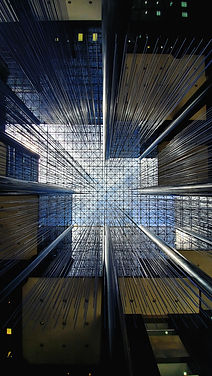WeTrack
A Mobile App for Delivery Tracking
I designed the WeTrack app specifically for overseas deliveries, catering to those who are waiting for a package without being sure of its delivery time. I implemented convenient features for tracking deliveries within the app, with the aim of allowing users to seamlessly manage their packages while continuing with their daily routines.
SUMMARY
My role
My role as the UX designer involved leading the WeTrack delivery tracking mobile app design. My tasks included conducting interviews, creating paper and digital wireframes, developing low and high-fidelity prototypes, conducting usability studies, ensuring accessibility, and iterating on designs. Using tools such as pen & paper, Sketch, and Figma, I worked on this project from October 2022 to December 2023.
🎯 The challenge
For busy workers and commuters, time is precious and often in short supply. Trying to fit deliveries into already packed schedules can be tough. Missed deliveries or needing to reschedule just adds to the stress. It leaves little time for other important tasks.
🏆 The solution
Design an app for WeTrack that enables users to 'track'and 'manage' their deliveries with ease.
The integration of the app with the delivery tracking systems will provide provide accurate information to the users.
Here are some of the animated screens.

01. Real-time tracking
Experience real-time package tracking, enabling users to follow their package's journey from the warehouse to its destination on a map. This feature allows users to plan their day around the delivery, providing peace of mind.
02. Stay in the loop
No need to constantly check the app for delivery updates—receive real-time notifications. Users get timely alerts when their packages are on the way or have been delivered.


03. Rescheduling
Balancing a well-organized schedule within a busy lifestyle can be challenging. People need the option to reschedule and adjust the delivery date and time of their packages, ensuring a better alignment with their lives.
04. Click & Collect
Plan package pickups in advance based on your schedule.

Understanding the user
Research
I conducted interviews and created empathy maps to understand the needs of time-constrained working adults, the primary user group identified through research. These users encounter challenges with their package journeys and rescheduling.
The interview script can be viewed here.
Pain points
1
Time
Users face frustration when disruptions, such as delays or changes in the delivery process, prevent them from receiving products at their preferred time.
2
Updates
Users experience uncertainty and anxiety without real-time tracking information. Lack of timely updates on package location and delivery estimates leaves users unsure about the arrival time.
3
Tracking
Users with multiple packages from different sources face challenges in tracking and managing them. The complexity of monitoring deliveries from various sources can lead to confusion and inefficiency.
Meet the user
Age: 30
Education: University
Hometown: Amsterdam
Family: Spouse
Occupation: Marketing Manager
Jasmijn

I love the convenience of online shopping, but sometimes I worry about missing a delivery or not being able to track my packages. I often have to stay at home for hours waiting for a delivery, and it's frustrating when it doesn't arrive on time.
Problem statement
Jasmijn, a busy marketing manager, needs a solution that allows them to track and manage packages coming from multiple sources. Because their pain points include limited delivery time options and not being able to see the location of the package.
Goals
-
Easily track her packages and know exactly when they will be delivered.
-
Schedule deliveries at convenient times that work around her busy schedule.
-
Minimize the amount of time spent waiting for deliveries or dealing with delivery issues.
Frustrations
-
Difficulty in keeping track of packages from multiple sources.
-
Lack of flexibility in delivery times.
-
Limited options for rescheduling or changing delivery addresses.
-
Inconvenient delivery options that require her to take time off work or wait at home all day.
Bio
Jasmijn is a busy professional who works long hours and often has to travel for business. They enjoy the convenience of online shopping. But find it difficult to keep track of their packages and schedule deliveries around their busy schedule. They live alone in a small apartment in Amsterdam and value their free time to explore the city, go to the gym and spend time with friends.
Age: 32
Education: Master
Hometown: Rotterdam
Family: Married,
with a 1-year-old daughter
Occupation: Software engineer
Thomas

As a busy professional and father, I need a package tracking app that allows me to easily manage my deliveries and fits into my busy schedule. I don't have time to constantly check for updates, so I need something that will notify me when my package is on its way and when it's been delivered.
Problem statement
Thomas, as a software engineer and a father, needs a solution that can support them in their busy schedule and provide guidance in the right direction. Because they faces difficulty in constantly monitoring updates on his deliveries.
Goals
-
To easily manage their package deliveries.
-
To receive notifications about the status of their deliveries.
-
To have a package tracking app that fits into their busy schedule.
-
To save time and avoid the inconvenience of missed deliveries.
Frustrations
-
Juggling work and family commitments while also tracking their packages.
-
Difficulty in constantly checking for updates on their deliveries.
-
Concerns about missing deliveries or not being able to track them efficiently.
Bio
Thomas is a busy professional who values efficiency and productivity. They work long hours as a software engineer at a tech company in Rotterdam, and often have to bring work home with them. On weekends, they enjoy spending time with their family and exploring the city. They love the convenience of online shopping, but find it difficult to keep track of their packages while juggling work and family commitments.
User journey
Mapping the user journey enabled me to analyze pain points and identify opportunities to address in the WeTrack app.
Goal: Analysis of the preference and experience of a package delivery app.
(Click on the image below to enlarge.)
Ideation
Competitive audit
An audit of a few competitor’s products provided direction on gaps and opportunities to address with the WeTrack product.
Click to view the full competitive audit and audit report.
Problem statement
Through interviews and competitive analysis, I discovered several difficulties related to tracking deliveries. I then selected the most significant problem statements for more in-depth exploration.

Statement 1:
How might we make it easier for users to 'track multiple packages' from different carriers in one place?
Statement 2:
How might we 'provide more accurate delivery time estimates' to users?
Statement 3:
How might we 'improve the notifications' and 'alerts' users receive about their deliveries?
Statement 4:
How might we make it more convenient for users to 'modify their delivery preferences' or 'reschedule deliveries'?
After assessing competitors, I found shortcomings in their products, inspiring me to generate ideas for enhancing the WeTrack app. My primary focus is to aid users in time management and improve their overall experience, prioritizing features such as 'real-time tracking,' 'instant notifications,' and 'delivery rescheduling options.'

Starting the design
Paper wireframes
Next , I sketched out paper wireframes for each screen in my app, keeping the user pain points about 'package adding' and 'tracking'. The paper wireframe variations of the home screen at the bottom focus on optimizing the product adding experience for users.
*Stars were used to mark the elements of each sketch that would be used in initial digital wireframes.

Digital wireframes
As the initial design phase continued, I made sure to base screen designs on feedback and findings from the user research.
1
This button provides users with a convenient and straightforward way
to track their shipments
or packages in
real-time on a map.

1
2
2
This button provides an easy option for users to add their shipment or package to the app for tracking.

3
3
This button allows users to save their packages in the delivery tracking app.
Low-fidelity prototype
Once the digital wireframes were completed, I used them to create a low-fidelity prototype, with a primary focus on building a delivery. This allowed the prototype to be used in a usability study to test the user flow and identify any pain points or areas for improvement.
The WeTrack's low-fidelity prototype can be viewed here.
(Click on the image below to enlarge.)
Usability study
Study type
Unmoderated usability study
Location
The Netherlands, remote
Participants
5 participants
Duration
20-40 minutes
#Parameters
#Findings
These were the main findings uncovered by the usability study:
1
User Familiarity
User Familiarity: Some users were not familiar with the app's features and functionalities.
2
Interface
Users felt uncertain and impatient due to the absence of a clear map or progress bar to visually track the progress of their packages.
3
Filtering
Users with multiple packages from different sources experience confusion when tracking their deliveries.
Mockups
01.
Based on the results of the usability study, I added a visual page as an introductory screen to guide users about the app's features and provide a brief overview. This will help users understand the functionalities of the app and assist them in getting started.
Before usability study
After usability study



02.
As a result of the second usability study, I implemented a filtering feature enabling users to sort and manage deliveries based on their status (current, past, and all deliveries). This enhancement aims to assist users with multiple packages from various sources in tracking their deliveries more efficiently.
Before usability study
After usability study


03.
The usability study identified challenges in date selection, understanding available time slots, and making schedule changes. To improve overall usability, I prioritized creating a more intuitive and flexible calendar experience to address these challenges. Additionally, I enhanced the accessibility of the 'home delivery' and 'pick-up' options.
Before usability study
After usability study


High-fidelity prototype
The final high-fidelity prototype presented cleaner user flows for delivery tracking app. It also fulfilled the user's need for enhanced customization options.
The WeTrack's high-fidelity prototype can be viewed here.
(Click on the image below to enlarge.)
Accessibility considerations
1
I implemented accessible color combinations, meeting guidelines to ensure readability for users with visual impairments.
2
I enhanced app accessibility by employing clear and concise language.
3
I prioritized spacious and easily accessible touch targets and interactive elements in the design.
Style Guide
The WeTrack app's color palette blends vibrant blues, representing trust and dependability, with energetic shades of red symbolizing speed and efficiency. These captivating hues infuse life into our app, ensuring that every interaction is visually delightful and engaging.
Typography plays a crucial role in conveying our message. Carefully chosen typefaces strike a balance between legibility and personality. The Roboto font family exudes a modern vibe and elegance. This harmonious typographic system effortlessly guides users through our app's interface.
Colours
Typology
Going forward
Takeaways
Impact:
The WeTrack app supports users, making it an efficient and user-friendly delivery tracking companion.
As one user aptly put it, 'The app enabled me to efficiently schedule my delivery waiting process and manage other errands seamlessly! I would definitely rely on this app for order tracking.'
What I learned:
While designing the WeTrack app, I realized that initial ideas are just the beginning of the process. Usability studies and peer feedback played a crucial role in shaping each iteration of the app's designs. Implementing the right technology for the product is essential to achieve desired goals.
Next steps
1
Conduct another round of usability studies to validate whether the pain points users experienced have been effectively addressed.
2
Conduct more user research to determine any new areas of need.
3
Encourage users to provide feedback and report any issues or errors they encounter with the tracking system. Monitor user feedback and address reported issues to improve the overall performance and accuracy of the tracking system.





